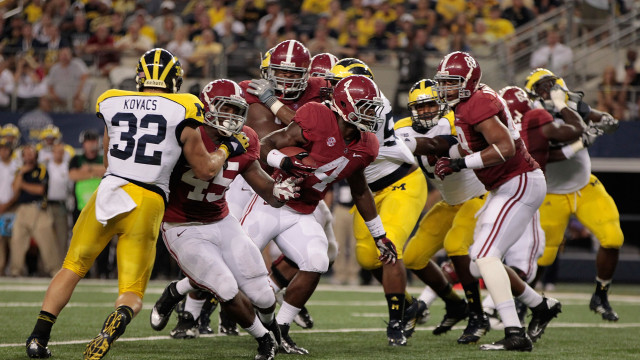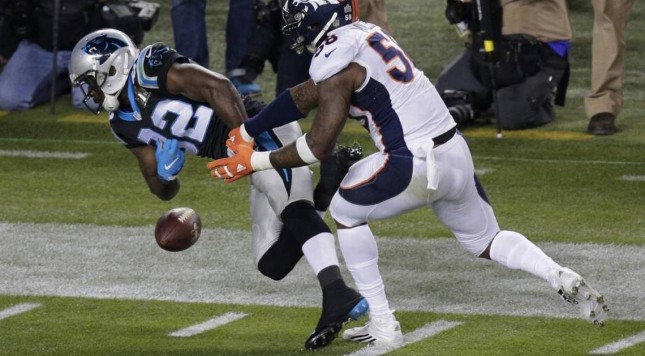Let’s get two things out of the way, just to frame this article the way it’s meant to be received:
First, what follows will not be an argument for an eight-team playoff. It will reaffirm what was said here at our partner (and hub) site, The Comeback, just after the New Year’s Day bowls ended. Read that article if you want to consider (and debate) a plan for how to improve college football scheduling in the coming years. Advocates of an eight-team playoff and supporters of a four-team playoff (i.e., no mission creep or expansion) should both find that plan to be valuable, if flawed. Improvements to college football scheduling can emerge without having to expand the playoff field to eight.
Second, and more simply, this commentary will not suggest that the NFL is better than college football, or that college football has to become more like the NFL. When one realizes that the NFL allows 9-7 teams to host 10-6 teams in the playoffs, and that 7- or 8-win teams can get into the playoffs (and host games) while 10-win teams get left out, it’s clear that college football — for all its deficiencies — now has a reasonably comparable playoff system with its four-team field.
College football had an inferior system with the Bowl Championship Series, but the College Football Playoff is now on par with the NFL playoffs. It might be better (I think it is), but the more important point is that it certainly isn’t worse.
At any rate, what follows below — in reference to Super Bowl 50 and the Super Bowl on a general level — should not be seen as a statement comparing the NFL to college football. The lessons offered by SB 50 go beyond those familiar (and worn-out) talking points.
*
We start with an editorial from Ben Swain, a thoughtful commentator on ACC sports who is the news director for SportsChannel8, a North Carolina-based web outlet:
Anyway, I (very poorly) scribbled some thoughts on why it’s a good thing Cam handled it poorly. https://t.co/WqneJijMqi
— Ben Swain (@TheBenSwain) February 8, 2016
No, this isn’t about Cam Newton, either.
What’s particularly relevant in Swain’s column — said with a keen understanding of events — is how the Super Bowl reshaped the Carolina Panthers’ mindset… and not in a good way.
Swain notes the two times the Panthers lost this past season: “first in Atlanta, coming off of the New York Giants game where there was incredible external pressure to reel in their personalty, and again in the Super Bowl, where there’s such an inescapable myth that you have to respect the magnitude of the game. For Carolina to make it back to the Super Bowl, the fun has to be there.”
Let’s focus on the part about the Super Bowl. It is the gateway to some lessons (or perhaps just reminders) about neutral-site competition. To that extent, Super Bowl 50 and the Super Bowl at large both have some lessons (or reminders) to offer to college football.
The first and most basic takeaway from the Super Bowl is precisely what Swain pointed out: After playing two playoff games at home — games in which they played (and coached) with a sense of fun and freedom — the Panthers struggled with the strangeness and unfamiliarity of the Super Bowl. The weight of the event, the lack of a normal game setting, the sideshows — those components, along with an inspired and great Denver Bronco defense, rattled the Panthers’ offense. (The defense, especially Kony Ealy, did virtually nothing wrong in a marvelous performance.)
The cover photo for this story shows Jerricho Cotchery committing his biggest drop on a day when multiple Cam Newton passes slid off his fingers (not including the catch he made in the first quarter, unpardonably ruled an incomplete pass by Clete Blakeman, who was as bad at his job as Phil Simms is at color commentary). If Von Miller was the game’s MVP, Cotchery was the No. 2 MVP — for the Broncos. That dropped pass at the Denver 4 represented Carolina’s best — and last — chance to take a second-half lead. Once that moment came and went, the Panthers were behind the eight-ball against a defense which wasn’t going to make many more mistakes.
The larger point of it all is that Cotchery and Carolina’s offensive linemen did not handle the moment well. If this game had been played in Charlotte, the outcome is very likely different. Even in Denver — with no 30-minute halftime show or any avalanche of pomp and circumstance — the Panthers might have played a more emotionally liberated game.
The Super Bowl — not just a carnival or a corporate orgy, but played in a neutral site with atypical gameday rhythms — certainly affected the Panthers’ performance.
This is where the discussion pivots to college football.
Over the course of the regular season, Carolina had a better record than Denver. Accordingly, it is perfectly reasonable to think and feel that the Panthers — in an ideal world — should have hosted Denver in the championship game. The Super Bowl’s neutral-site identity would be (or already is) a negative in assessing the NFL’s system.
This is where something needs to be said: Neutral-site games are not the scourge many college football writers and pundits think they are.

ARLINGTON, TX – SEPTEMBER 01: T. J. Yeldomn #4 of the University of Alabama runs for a short gain during the first quarter of the game against the University of Michigan at Cowboys Stadium on September 1, 2012 in Arlington, Texas. Alabama defeated Michigan 41-14. (Photo by Leon Halip/Getty Images)
Yes, I wouldn’t dispute the claim that it’s better to have on-campus regular season games between top teams than neutral-site games in which Nick Saban carefully picks the venue (not too far away from home) and the opponent. Give me a home-and-home over a neutral-site stand-alone game any day of the week.
However, let’s counterbalance our ideals with a longer view: It’s far better to have neutral-site contests than for top teams to go the cupcake route. Since college football programs get to schedule non-conference games themselves (scheduling is discretionary in those cases), the presence of neutral-site games should be welcomed a lot more than it is. Better any showcase than FCS or Sun Belt cream puffs.
Beyond that point, however, something else about neutral-site football emerges to the surface in the wake of the Super Bowl: It represents a different kind of test. That’s good for college football, given the dynamics of the sport as it exists.

In the NFL, Southern teams have to play in Northern cities in December or January (at least on some occasions). College football doesn’t have that. It might seem desirable to have on-campus playoff games, but if Alabama will always get the benefit of the doubt when it comes to seeding, the reality of Southern teams hosting games wouldn’t change. Neutral-site postseason games serve as a buffer against seeding controversies. It’s an important point to keep in mind.
It’s true that neutral-site postseason venues in college football are limited in their geographical placement. The New Year’s Six bowl games are located in California, Arizona, Georgia, Florida, Texas, and Louisiana. Cold-weather locations with outdoor stadiums need not apply. This reminds us of the Big Ten’s longstanding and very legitimate gripe that it never gets to play SEC teams in Madison or Ann Arbor in late November. The games between the schools are always in some sunny or domed location in early January. That’s not fair, and it never will be.
Anything to level the playing field should be welcomed in college football. The idea of teams hosting playoff games sounds agreeable on the surface, but when you realize that Alabama will generally be seeded higher in a four-team playoff (as we’ve seen each of the past two years — the Tide really did not deserve to be the top seed in 2014 or the 2 seed in 2015), on-campus games would create raging arguments about seeding as the College Football Playoff moves forward.
Neutral-site playoff games serve as a buffer against seeding controversies — not an airtight seal, but at least something to dramatically lessen the force of a mistake by the committee.
All these things matter when contemplating the ways in which the neutral-site Super Bowl changes the competitive balance of a game.
There’s one final point to be made about seeing Denver beat Carolina.
The team with the best record in the NFL during the season (one can say, “the best team during the regular season”) did not fare well against an opponent it hadn’t faced, from a conference in which it didn’t play. Yes, the NFL and college ball are not the same — not when one entity has four-team divisions and the other has 12- or 14-team conferences, and when one league has 32 teams, the other four times as many (roughly twice as many in the Power 5 conferences alone).
However, it can still be said that Carolina was protected in the NFC South to an extent that wouldn’t have existed in the NFC West (where the Panthers used to play in the geographically inaccurate 1990s). Carolina fully deserved to host two playoff games and get a first-round bye. The Panthers deserved to be favored in Super Bowl 50.
However, there was — and is — something substantial about forcing this 17-1 team to face (and overcome) a challenge in a neutral setting, not just a comfortable setting, in order to win the world championship. Much as the NCAA basketball tournament forces teams to win with ample preparation (the Thursday or Friday game on a weekend) and then short preparation (the Saturday or Sunday follow-up), thereby revealing the best of the lot, the inclusion of a neutral-site game unmasks something similar in a football team.
We don’t need to wonder how Alabama does in the SEC every year. We want to see the Tide thrive in unfamiliar settings, ideally in different geographic locations. Glendale, Arizona, certainly qualified against Clemson. Oregon handled the 2015 Rose Bowl against Florida State, but that offered a favorable location. When the Ducks had to go to Texas against Ohio State, they didn’t play with anything close to the same level of precision they displayed against Florida State.
It’s true that the Denver Broncos defeated the Carolina Panthers more than anyone else on Sunday, but the Panthers — and the weight of the Super Bowl — certainly had more than a little to do with the outcome as well. Playing that one extra game against an unfamiliar opponent in a strange setting reveals much about a team. This is why it would be great if Iowa had been made to play a neutral-site game of consequence before stepping into the Rose Bowl.
Don’t get me wrong — it’s great that Iowa had that chance to prove itself in Pasadena. It was the experience of a lifetime for Iowa fans to be there. They and their team deserved to be there, based on what they did in the regular season. Yet, it’s not unfair or uncharitable to ask a team in Iowa’s position to play a made-for-TV game against, say, North Carolina or Oklahoma State before going to the Granddaddy.
Playing that one extra game — especially on a neutral field — often separates teams in ways we don’t expect.
Four of the last five Super Bowls have been won by the Vegas underdog. A betting underdog has won a semifinal in each of the first two College Football Playoffs (Ohio State in the 2015 Sugar Bowl, Clemson 364 days later in the 2015 Orange Bowl).
What’s your view of the Super Bowl and the College Football Playoff?
I don’t know about you, and I don’t live in Switzerland, but I’m decidedly “neutral” on the matter.


